Don't wanna be here? Send us removal request.
Text
'I'll meet you there"
( a brief history of gathering places from Stonehenge to Santiago de Compostela)
Intro
The thesis I would like to focus on is to analyze the spirit of togetherness, kinship, and the desire to be a part of a community with shared values that has always characterized the human species and how this desire translated into magnificent gathering places. These gathering places were used for different purposes, from religious to civic life and entertainment. How each end every one of these places was simultaneously a testimonial and a mirror of the societies they served.
Chapter 1 "Stonehenge"
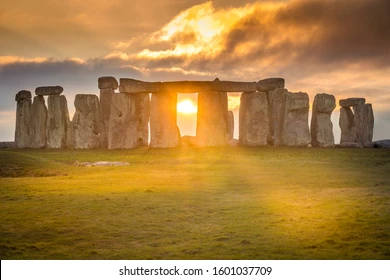
June 20, 2400 bCE . "I'll meet you there! Tomorrow is the Summer solstice and the sun is going to rise lining up perfectly with the shadows of the stones. The whole village will be there, and people from the other villages too". If we can imagine a conversation between two prehistoric people, somewhere where modern-day England is and where Stonehenge is situated, that's probably what they were saying. Stonehenge, a structure whose purpose is still an element of debate, was used as a ritual place during winter and summer solstice, and as a burial ground even before,probably since 3100 bC(Pitts 102). The site was built with a combination of bluestones and sandstone boulders, called sarsens. The sandstones came from relatively nearby, but the bluestone arrived all the way from Wales.This is one of the most iconic places of England, a testament to the ancient civilization's need for gathering together , to celebrate the beginning of the season, the passage of time, the burial of the dead. Across centuries and millennia, we strive for the same, united by our shared values and the spirit of togetherness.
Chapter 2 Persepolis
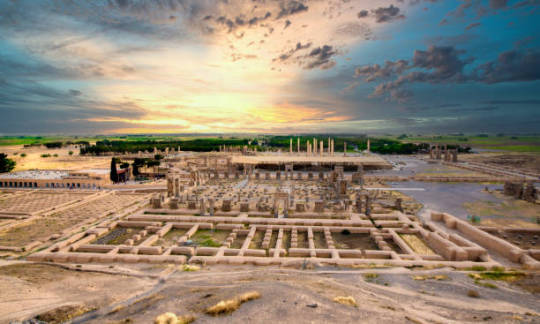
September 12, 485 BC. "I'll meet you there!"- "Where?" "In the Apadana at Persepolis! King Xerses the First is going to make a great speech! Thousands of people are going to gather!". If you were a citizen of Persia in the fifth century BC, you might have participated yourself. The ruins of this place show us a complex citadel designed with a precise function: to serve as a center for ceremony and governance activities. (Gates, 186-7). The fact that the Apadana at the center of the complex could host thousands of people tells us about the importance that this society gave at these events. The complex is an example of the Achaemenid style, which, like Persian civilization, was an eclectic fusion of many other cultures, including Mesopotamian, Assyrian, Egyptian, and Greek. This complex well reflects its society, where the King was the center of power and ruled with absolute authority. All the civic participation that the citizens were allowed to do was to celebrate the figure of the King. Nonetheless, the continuous contact with other cultures led the Persians to be a highly refined civilization, and the structure and decoration of Persepolis are a testimonial to this greatness.
Chapter 3 The Parthenon
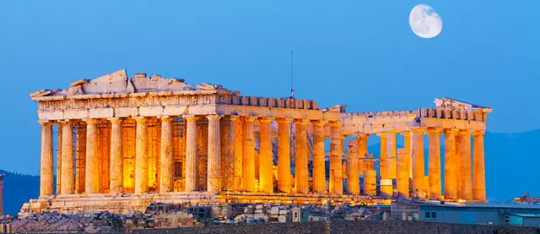
August 20, 401bC."I'll meet you there!"- "Where?"- "At the Acropolis, right by the Parthenon. Socrate is going to be there; you should listen to his speeches! Fascinating stuff!" The Acropolis and the Parthenon have become symbols of the beginning of Western culture and democracy. Imagine being a Greek citizen of the era and engaging in the civic, intellectual, and artistic life of the city just by strolling around the Acropolis. The Parthenon, originally conceived as a temple dedicated to Athena, is perhaps the first structure that comes to mind when we contemplate the concept of democracy. It has been hailed as the 'culmination of the Doric Order,' a testament to the architectural prowess of its time. Doric Order." The refinement of this building is legendary, especially considering the counteracting that the builders did to avoid the optical illusion of bending lines ( Norwich 69). Unfortunately, as often happens to many great buildings of the past, the statues and decorations that originally decorated the Parthenon have been looted by colonial powers that took control of the area over the centuries and now display, controversially, at the British Museum. Nevertheless, the sequence of statues that used to adorn the East Pediment ( now displayed in London) gives us a glimpse of the splendor of these magnificent buildings. The Athenians were right to be proud of their achievements and ideals, just like their beautiful buildings, which are a reflection of one of the finest civilizations of the past.
Chapter 4 The Colosseum
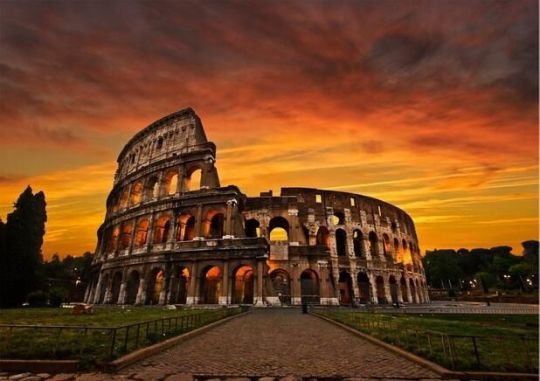
April 20, 79 AD: "I'll meet you there!'-"Where?"- "At the Colosseum! Tomorrow is the Great Inauguration! Emperor Titus promised one hundred days of games and entertainment! They say they will even flood the stadium and have ships battling inside! There will be a sold-out crowd! Fifty thousand people! I'll meet you there!". Imagine the excitement of being a Roman citizen during the Flavian dynasty, one of the greatest periods of the empire. The old and wise emperor Vespasian just died last year, and his son, Titus, is ready to inaugurate his father's legacy public project: a fifty-thousand-seat stadium where all kinds of entertainment will be displayed. The Flavian Amphitheater was built with travertine and tufa blocks and concrete. Its exterior was decorated with worked stone, and the engaged columns flanking the arches had a different architectural order for every level. Unlike many other gathering places of the past, the Colosseum was built not for religious purposes or civic ones. It was a place to entertain the masses. The fact that the arena floor was covered in sand to soak up the blood of people and animals tells us what kind of entertainment it was. It was a mirror of the Roman society of the time: an Empire built on the military's strength and the engineers' genius.
Chapter 5 Hagia Sofia
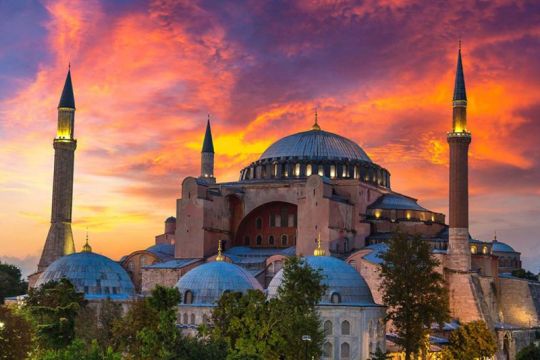
February 27, 532AD. "I'll meet you there!" Where?" "At the Church of the Holy Wisdom! You should see its dome! It looks like it is floating in the air!" When the Christian faithful entered this Church in the early Middle Ages, they saw something never seen before. The marvel that struck them was the enormous dome that appeared floating on a void. Anthemius of Tralles and Isidorus of Miletus achieved this effect thanks to four gigantic pendentives. The piers supporting the pendentives were skillfully concealed in the aisles, and to add to the dramatic impact, forty windows at the base of the dome would let natural light reflect on the inner gold decoration. The Building is the finest example of Byzantine architecture, rebuilt by Emperor Justinian after the destruction of the Nika riots. Never like in the Hagia Sofia, the history of the Building reflects the history of the city it is in. Born as a Christian church, after the great east-west schism of 1054, it became an Orthodox church. From 1204 to 1261, when Crusaders occupied Constantinople, it was converted to being a Catholic Church, and after the Crusaders' expulsion, it was restored to being an Orthodox church. In 1453, when the Ottomans conquered Constantinople ( and changed the city's name to Istambul), the Building was converted into a Mosque. In 1935, when Turkey, under the leadership of Kamal Ataturk, was going through a period of secularization, this magnificent place was converted into a Museum. Then again, in 2020, under pressure from the religious, political right wing of the country, it was once again converted into a Mosque. Something nonetheless never changed about this Building: its magnificence and the sense of wonder that inspires everyone gathering on this site.
Chapter 6 Kaaba
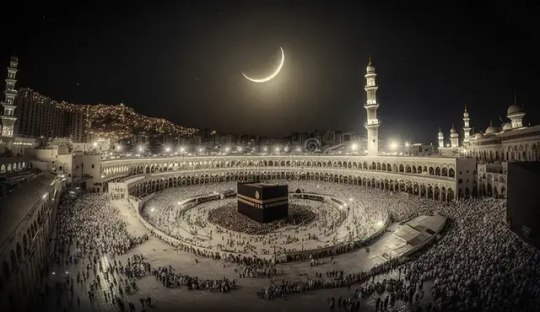
November 11, 978AD. "I'll meet you there. "Yes, God willing." Faithfuls of the Islamic Religion could have exchanged these words for centuries, referring to Mecca's Holiest site, the Kaaba. Quite surprisingly, the actual building predates the establishment of the Islamic faith. Kaaba, meaning "cube" in Arabic, was a holy site even before the birth of the Prophet. It is a simple cuboid, and in its eastern corner, there is what many believe to be a meteoritic rock set in the wall. Muslims reveal this rock as a relic. The pilgrimage to Mecca called the Hajj, is one of the five pillars of the Islamic faith. Every year, millions and millions of Muslims undertake the journey to reach the place. It is a transformative trip for the faithful, comprehensive of many precise rituals and many staggering logistical challenges. Nevertheless, pilgrims are not discouraged and keep on coming in huge numbers. The Hajj is one of the best demonstrations of the spirit of togetherness and community that pushes humans to gather in the same place. Islamic faithful arrive from different corners of the world, with different backgrounds and social and economic statuses. They often speak different languages and have different dreams. Yet, they gather and pray in peace and brotherly love, demonstrating the importance, in human experience, of those magnificent gathering spaces.
Chapter 7 Duhram Cathedral
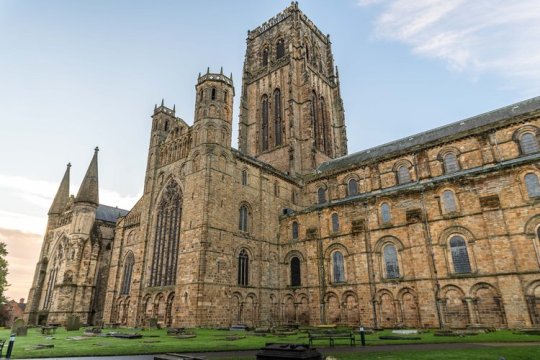
December 24, 1133. "I'll meet you there!" Where?" "At the Cathedral tomorrow, for the Christmas Mass." Those words could have been exchanged between two friends on a cold winter evening at the beginning of the twelfth century. We are in the far North of England, at the border with Scotland. The village is a fortification against the Scottish enemies just north of there, and the works are just finished on what is now considered one of the masterpieces of Romanesque architecture: the Durham Cathedral. Built on the ruin of a previous Saxon Church destroyed by Viking raids, this Building was designed by William De St.-Calais ( Tatton-Brown 29-29). Durham houses some of the earliest examples of the ribbed vaults on the nave and is, therefore, considered a precursor of the later Gothic style. Like many religious buildings of the era, the Cathedral preserves reliquaries of Saints, in this case, Saint Cuthbert, and was the destination of many pilgrimages from the surrounding areas. As often happens to many historic buildings throughout the centuries, its fortunes ebbed and flowed. In 1650, after the battle of Dunbar, this church was used as a makeshift prison for Scottish prisoners of war, many of whom died of cold and starvation. The prisoners destroyed much of the woodwork of the Cathedral for firewood. A series of restorations and renovations gave this place its status today. An inscription on nearby Prebends Bridge describes the place as "Half Church of God, half castle 'gainst the Scot". It remains one of the greatest cathedrals of Europe and a place where people gather; fortunately, those times are in peace and quiet admiration.
Chapter 8 Notre Dame de Paris
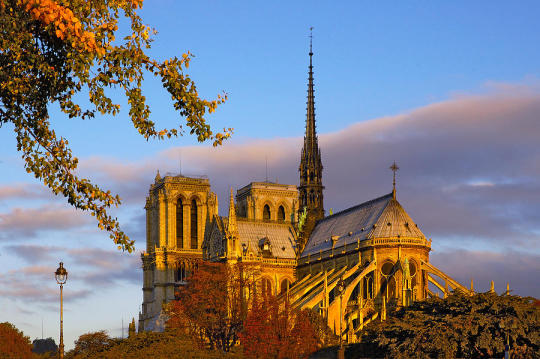
March 28, 1345. "I'll see you there! - "Where?" -"At Notre Dame for the Easter Mass". The Catholic faithful have gathered in this magnificent building for many centuries to celebrate the festivities. It is considered one of the masterpieces of French Gothic architecture. The construction began in March of 1163, and the extensive use of rib vault ceilings and flying buttresses made this building quintessentially gothic. This new technique, especially the flying buttresses, was an engineering revolution. Those buttresses, an external supporting structure, now controlled the weight of high vaulted ceilings (115 feet) and their downward and outward pressure. Doing so allowed for grand openings on the walls, where magnificent stained-glass windows filter the natural light, creating spectacular effects of lighting and color on the inside. Despite the Church always being a symbol of the Catholic faith of French people, during the French Revolution, from 1789 to 1802, it was deconsecrated, its interior and exterior seriously damaged, and used as a warehouse (Chavis 2013). In 1802 was finally rededicated, under Napoleon. Parisian gathered in this Church throughout the history of the city: during the coronation of kings, at the coronation of Napoleon in 1804, and to celebrate the liberation from the Nazis in 1944. In 2019, the people of Paris and the rest of the world watched in horror while a fire ravaged inside and seriously damaged a significant portion of the Church. The image of everyday people crying while watching this magnificent building being seriously injured by fire is a testimonial of how we tend to identify and love our gathering places, the symbols of our faith, our city, and our communities. Notre Dame is scheduled to reopen on December 8, 2024.
Chapter 9 Santiago de Compostela
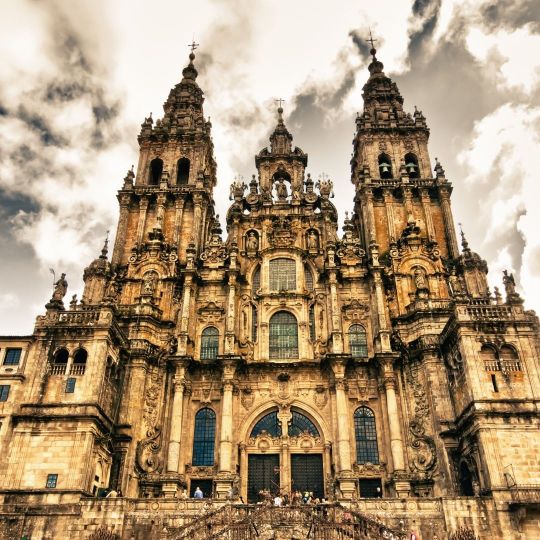
June 6, 1425. "I'll see you there." This time, a person of unwavering determination could have uttered these words hundreds of miles from the chosen gathering place. For this place is the endpoint of one of the most physically demanding and awe-inspiring pilgrimages of Christianity, The Way of Saint James. The journey, a true test of endurance, traditionally commences on the French side of the Pyrenees mountains and traverses the north of Spain, culminating in Compostela in Galizia. The Cathedral, a symbol of triumph and resilience, awaits pilgrims at the end of this grueling journey. It has witnessed numerous renovations, and each facade displays now a different style. The interior, however, remains a sanctuary of Romanesque architecture. The nave and the transepts boast barrel-vaulted ceilings, while the main altar houses a golden reliquary containing the sacred remains of Saint James, both hallmarks of Romanesque churches. This place has been chosen as the final gathering place for millions of pilgrims undertaking a spiritual journey . Pilgrimages are ancient rituals, a way to feel closer to the Divine. Since the ninth century, Santiago de Compostela has embraced the pilgrims with open arms.
Conclusion
The magnificent places described in this project symbolize the human need to gather, be together, and pray together. Analyzing their history and architecture, we witnessed different cultures and societies. We traveled across many miles and many centuries. Despite all those differences, we recognize that the human spirit is united in the desire to join our fellow humans. The majesty of those buildings bears witness to this desire. To be human is to be together.
Works Cited
Pitts, Mike (8 August 2008). "Stonehenge: one of our largest excavations draws to a close". British Archaeology (102): 13. ISSN 1357-4442.
Gates, Charles (2011). Ancient cities: the archaeology of urban life in the ancient Near East and Egypt, Greece and Rome (2nd ed.). London: Routledge. pp. 186–187. ISBN 978-0-203-83057-4.
"Parthenon". Britannica Library, Encyclopædia Britannica, 10 September 2021. Accessed 16 July 2022.
Tim Tatton-Brown and John Crook, The English Cathedral pp. 26–29.
Chavis, Jason. "Facts on the Notre Dame Cathedral in France". USA Today. Archived from the original on 23 October 2013. Retrieved 3 August 2013.
0 notes
Text
Final Exam
The inspiration for this final assignment was given to me by many articles I read about the making of the trophy for the World Cup of soccer. A little, family-run Italian factory and its chief designer, goldsmith and sculptor Silvio Gazzaniga, won an international competition among more than fifty international designers with their new, and now iconic design of the cup.
I decided to create a trophy cup.
Now, given the fact that at this very moment I don't have at my disposal about six kilos of pure gold like Mr. Gazzaniga did , I took another inspiration from artists like Vik Muniz and their capacity to change through their creativity garbage into art. A shoutout also to the Italian movement "Arte Povera" of the late 1960s and early 1970's.
I started by taking a look inside the recycle bin and I found some interesting stuff...
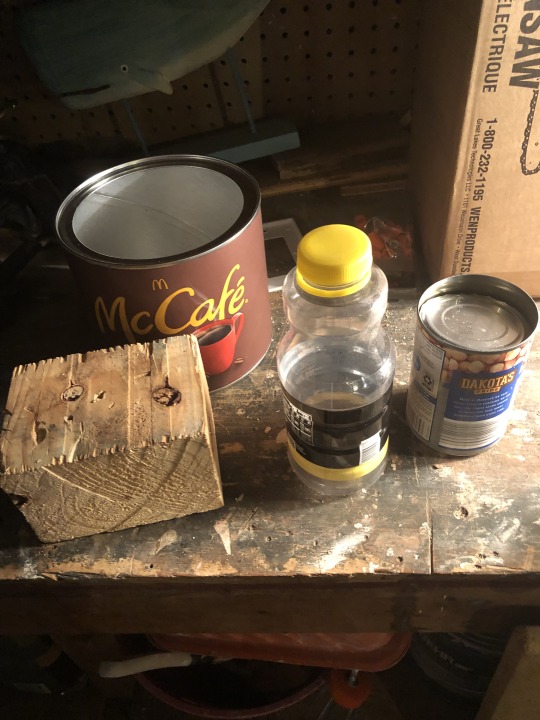
The design I had in mind had a solid base, representing training and sacrifice needed as a base for every success , an elongated body, representing the strive, and finally, the actual cup , with a progressively bigger diameter, representing victory. For the base, I chose the chunk of wood. With its weight to the bottom it would give more stability to the piece. I had to smooth the imperfections of the wood using wood filler paste

The next step was to find a way to attach the plastic bottle to the base. I found this part challenging because the result was somehow wobbly. I fixed the problem by using five screws instead of the original one. This is one of the challenges of three-dimensional art, which not only has to be aesthetically pleasant, but it has to fiscally stand and not crumble down.
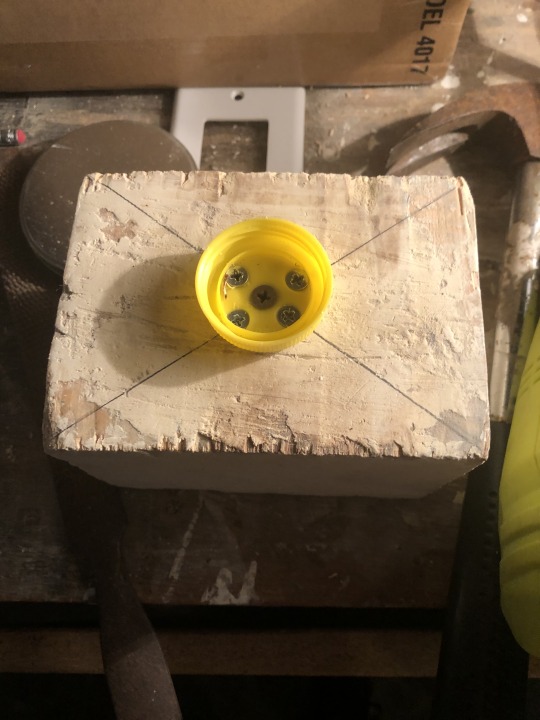
The next step was to add the cup, and this was relatively was relatively easier due to the light weight of the material chosen. In this way I distributed the three pieces of material I selected having the heaviest on the bottom/base and the lighter on top, adding more stability to the final product.
As written in the assignment one of the limitations we had to create this art project was money$$$. I decided to invest about twelve dollars and sixty-two cents into buying two spray paint bottles: one of primer, and one of shining gold. I bought the primer because I feared the gold paint wouldn't stick well to the smooth plastic material of the bottle.

And so I started to paint...

Although I was quite pleased with the final result, I thought it was missing something, some variety to the overall composition. I decided it was missing a label, so I went back to the recycle bin where I found an aluminum can that I cut, flattened and painted with my daughter's nail polish to get the final design.
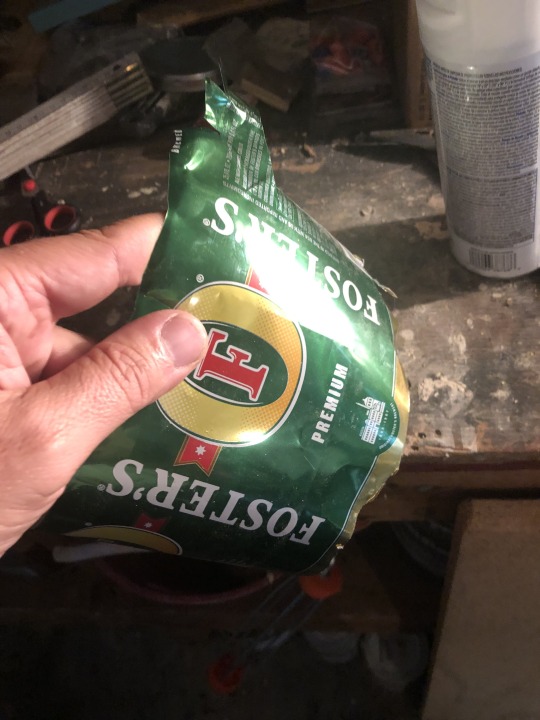
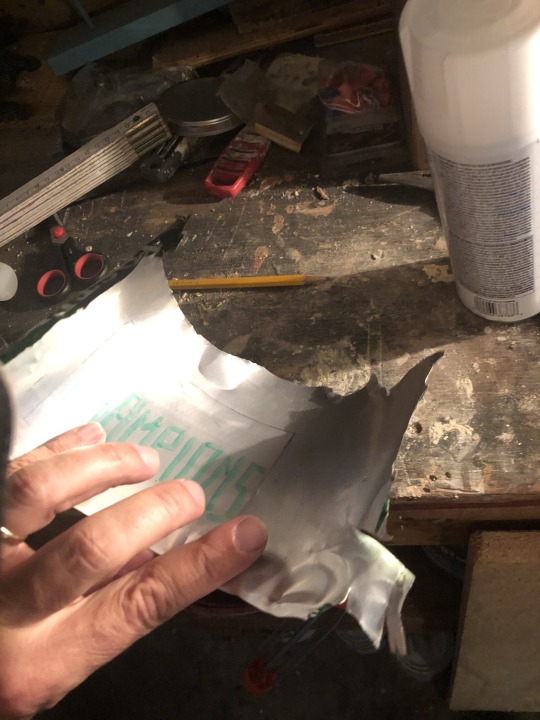

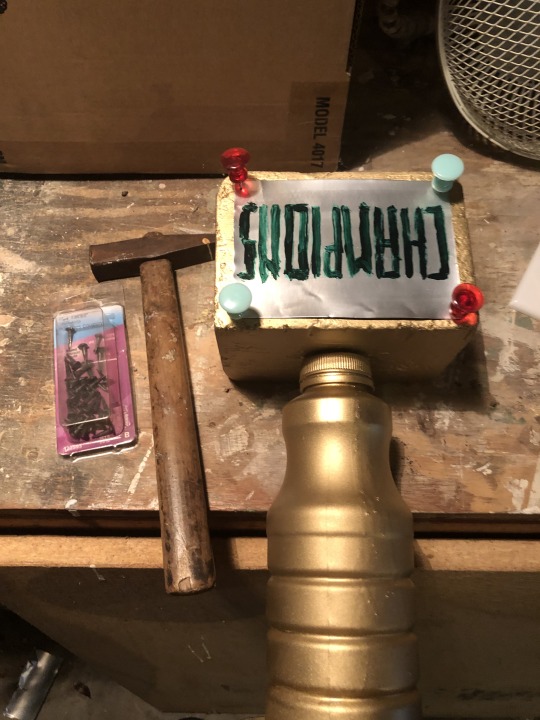
I nailed the label to the base of the trophy and voila, I achieved my final result. I believe it has an overall good balance, symmetry and proportion. For the final picture, I set up my garage/art studio with some interesting lighting and a blue background for dramatic effect.
I don't know if this is my first step into designing the next World Cup, but for now I am happy with this small victory.

0 notes
Text
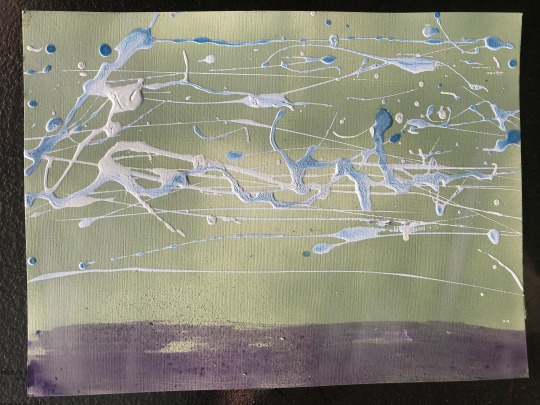
Virtual Sketchbook 4 - Art Project
Luigi Giannattasio. Memoria danzante di un tardo pomeriggio d'estate. 2023. Multimedia on paper. 9"x 12". Private Collection.
0 notes
Text
WRITING, THINKING AND LOOKING CRITICALLY:
Jackson Pollock
Before this assignment, I had only a superficial knowledge of Jackson Pollock. I knew his original style, his dripping technique, but little more than that. It was fascinating to know more about the man and the artist. Like many artists he was a tormented soul, fighting the demons of a fragile nervous system that kept him out of the draft for WW2, and the demons of alcoholism, which eventually killed him in a car crash while he was driving drunk. Unlike many artists at least, he had the fortune to become rich and famous while he was still alive, although maybe in a certain way, this fame destroyed him because it had him relapsing into alcohol to manage the pressure. How did he go from abstract imagery to removing all imagery in his drip paintings? it is a complex question, and I believe the answer lies in the need that every artist, ( and actually everybody) has to express themself. For the expressive genius of Pollock, forms of imagery, even abstract forms, represented an anchor, a weight that made him unable to fully express his potential. Once he finally liberated himself from the necessity to represent forms, he was able to unleash his creative genius in an explosive way, creating some of the absolute masterpieces of the twentieth century. Just like an air balloon is only able to fly when it drops the weights, Pollock needed to drop the forms to have the complete liberty to express himself. His critics of the time accused him of being chaotic, his painting of having no structure, no symmetry. But paintings like the ones from Pollocks don't need any of this. Their beauty lies in the way one feels while looking at them. In their color contrast. In their color choice. In the way the seems to dance toward the viewer, out of the canvas. Some of the most beautiful views we have are like this: a field full of flowers, a starry sky, a stormy ocean: they are not structured, or symmetrical. They don't need a critic's explanation. They're beautiful because they're beautiful. Period. They're beautiful because when we look at them we feel something inside. Something that makes us keep staring, that uplifts us. And here lies the creative genius of Jackson Pollock: in his ability to express his feelings and to inspire us without the need to point to forms, but just colors, paint, canvas, and emotion.
0 notes
Text
Art in the Real World
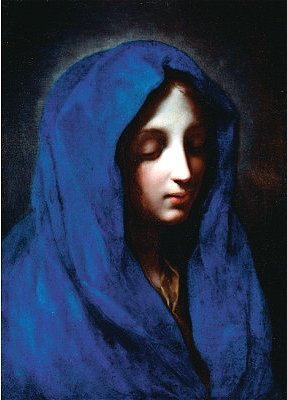
Title: Blue Madonna. ( Original title: "Mater Dolorosa") Author: Carlo Dolci. ( Attributed by some to his pupil and cousin Onorio Marinari) Italy, 1670s. Oil on canvas, Dimensions: 21" x 15.25" Ringling Museum, Sarasota, Florida. One of the most beloved paintings of the entire Ringling Museum collection, the Blue Madonna is a relatively small painting (cm 53 X 39) by Italian Carlo Dolci, nicknamed "il Carlino", active in Florence in the second half of the 1600s. Even though the name of Dolci is not widely known, he was one of the leading painters in Tuscany of his time. Of course in his time, and in general during the Baroque period, the pulsating heart center of the art world was no longer Florence, but Rome.
The painting is a simple image of a very young Virgin Mary, in a very lush royal blue robe, and it reminds of El Greco and its use of color to represent spiritual life. Dolci once stated his "firm intention to paint only works that would inspire the fruits of Christian piety in those who saw them." The "Mater Dolorosa" ( "Mother in Pain" the original title of this painting ) is one of the mysteries more renowned in the Catholic teachings: it describes how during the Annunciation, when the very young virgin Mary was visited by the archangel Gabriel, she was told that she would be the mother of the Savior. She was also told of her Son's crucifixion to redeem the sins of the world. Therefore, the young Mary already had in herself the pain of the death of his son, to be suffered thirty-three years later. It is a very beloved image in Catholic iconography: even Michelangelo, in his Pietà, represented it with a very young Mary carrying the body of Her adult Son.
The beauty of this painting is in its simplicity. The light falling from above illuminates the downcast face of Mary which seems to emerge almost supernaturally from the rich fabric of the blue robe. The influence of Caravaggio in the use and the contrast of lights and darkness for dramatic purposes is evident. The gaze of the viewer is therefore magnetically attracted to the sorrowful face. A single, simple subject, in a dark background. Dramatic use of a single color and of lights and shadows. Uniformity at its best.
I love this painting. As a Catholic myself, and having grown up in a household where almost every room had a painting of the Virgin Mary, I connected immediately. Furthermore, being from Rome, I am quite familiar with the sensory spell that baroque art can emanate. This work of art gave me the strange feeling of looking at something never seen before, and yet familiar. The day I visited the museum, it was deserted. I had all the time to observe closely the masterful brushwork of the artist. Dolci, I discovered, was painstakingly slow in completing his works, and because of the critiques of his contemporaries, he fell into a deep depression. I wonder if the sadness of this painting is also a reflection of the painter's interior struggle.
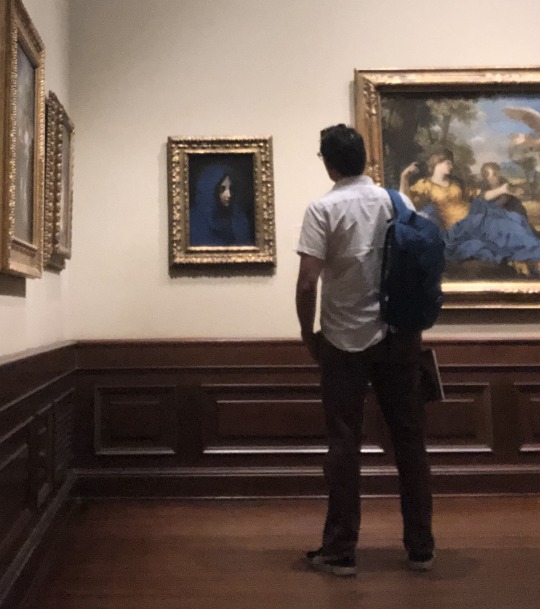
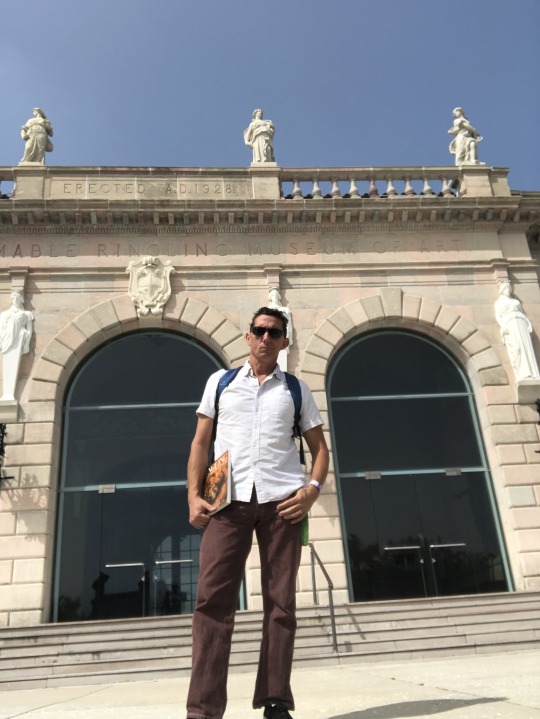
0 notes
Text
Journaling
1 Unity and Variety. This principle refers to the quality if an artwork been homogeneous or differentiated. A monotone piece, with a single or no subject, not many details can be referred as an example of unity. A multi colored, multi subject piece can be an example of variety. Fashion designer Valentino offers two great example here of diversity and unity in the designs of those two Kaftan.
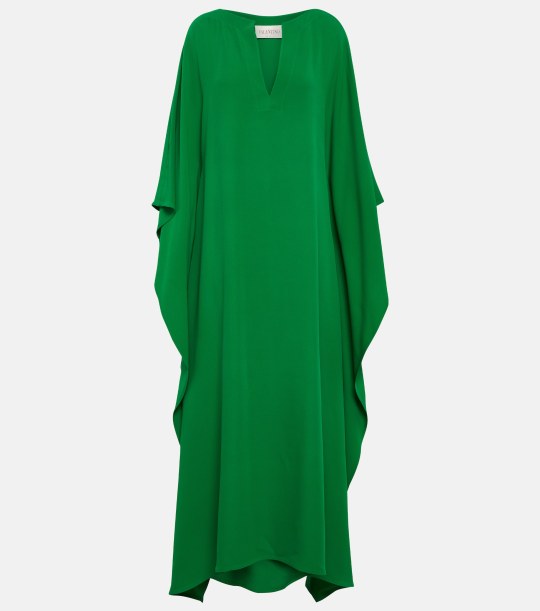

2 Balance. Balance, the achievement of equilibrium, gives a sense of calm and stability to the piece of art. Just like in life, reaching a good balance is important. A part of my life where a see a constant strive for balance is in automotive design. Regardless of the many artistic aspect of designing a car, and regardless of the target buyer, a car design has to be balanced in order to give a sense of stability and security. The cars that we see in the street nowadays all have a symmetrical design. The left and the right side identical, and they have a balanced proportion between the front and the back.


3 Emphasis and subordination A typical aspect of our life where we this principal of art is in Movie's posters. The emphasis is usually given by a central predominant position The figure of the main character usually in the middle of the poster while the subordination is given in placing secondaries actors in a non central position. The Poster of "The Riders of the lost Ark" is a good example of emphasis and subordination.
4 Directional Forces is a way to guide the eye of the viewer in a certain path in the work of art. In our life is often used for commercial promotion, leading the attention of potential buyers to the product. Often used is art depicting sport. This image of an old poster promoting the Tour the France is a good example of directional forces. Is almost impossible for the eye of the viewer to not follow the cyclist in the zig-zag of his path that forms the French flag.
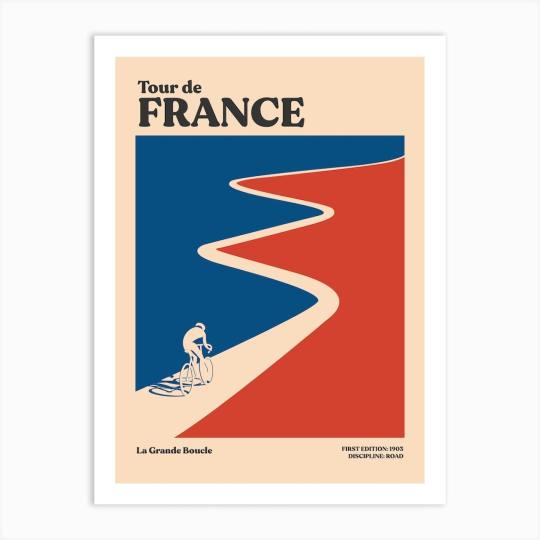
5 Rhythm and repetition .An area where we can see fascinating pattern of repetition is in Islamic art. While in Christian art the figure of the Devine is often depicted in human form, in Islamic art this is not possible for the following theological reasons. Both Christianity and Islam are logocentric religions, ( meaning religions based on the Word of the Lord) , but while in Christianity "the Word became flesh" (John 1:14) assuming human form, according to Islam the Divine never had a human aspect. And so Muslim artist express the transcendent and infinite figure of God through intricate pattern of repetition. Rhythmic and repetitive patterns are present in many religion( and in many prayers), inducing a state of transcendency ideal for religious meditation. The Nasir al Mulk Mosque in Iran is a majestic example of rhythm and repetition.
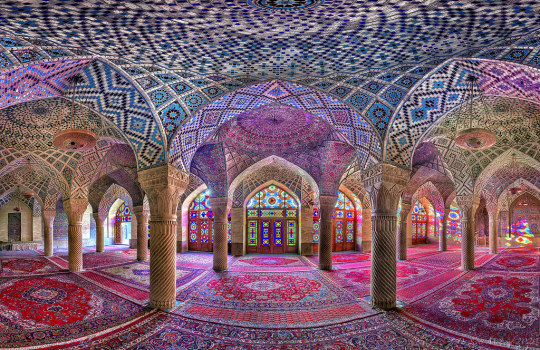
6 Scale and proportion. Scale refers to how big is the work of art, proportion refers to its size compared to its surrounding. Mount Rushmore I believe is a good example where the simple size of the work make it extraordinary. Artists often "play" with the scale of art to emphasize certain message they want to express.

1 note
·
View note
Text
3 CONNECTING ART TO YOUR WORLD I am not completely sure that what I am going to say can be fully understood by somebody who didn't grow up in the same environment I did, but trust me when I tell you that millions of people around the world would comprehend me immediately. If I had to pick a color scheme for my life, it would be, without any doubt the color of my favorite soccer team, of my city, of the banners of the many Roman legions that conquered the world: the yellow and red of Rome. Not just any yellow or any red. Golden yellow and Pompeian red. Two warm colors, two primary colors. Those colors have been my companions since I was a kid when I used to dress in my little soccer uniform. Later I became a season ticket holder for the team. The fans, just like the colors, are notorious for being very warm and passionate. The Sundays were an explosion of yellow and red. Flags, scarves, banners. At the beginning of every game, somebody would throw several smoke bombs (yellow and red smoke, of course), creating an intense fog. Because of this, I can say literally that I breathed these colors deep into my lungs. It is maybe because the youth growing up in the degraded outskirts of a big city needs a sense of belonging to make it through, but ever since,these colors are my colors.
0 notes
Text
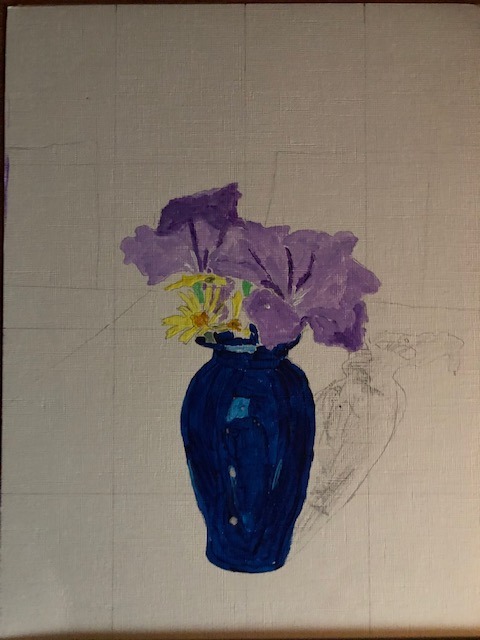
4 ART PROJECT - ARTIST CHOICE
Giannattasio, Luigi .2023 Bleu vase. Acrylic on acrylic paper. 9"x12"
This is a painting of a bleu vase that has been in my home for many year. I like different hues of the bleu glass under different lights. The reason why this object really has a deep, personal meaning for me is because I see it as the vase that always hold the flowers that I buy or I pick up for my wife and my daughter. It has therefore a very special connotation for me. This vase has seen birthdays and anniversaries, Christmases and Easters, alway holding different flowers.
0 notes
Text
2 Writing and Looking
The painting I choose is Going Home by Jacob Lawrence fig4.4. I believe is a good example of unity and diversity. Unity given by the repetition of chairs all across the length of the piece, the recurring green, the recurring red. Diversity is given by the many subjects depicted all busy in different activities. The repetition of geometric shapes, of the green, and of the windows of the train give to this painting the overall sense of the fast rithm of the train. The choice of vibrant colors and the repetition of green and red, two opposite color in the color wheel, add to this sense of movement
0 notes
Text


Group 6 Black and White vs. Color photography Those two pictures are indicative of how color itself is a part of the message that the photographers want to express.
The black and white one is somehow a sad picture taken on a rainy day and tells the story of this unhappy child unable to go out and play. The choice of black and white perfectly matches and enhances the overall mood of this little girl. The angle of the face of this child, and the little hand on the glass seems to express a longing for the return of the sun ( and we can even say for the return of colors).
The color pic has the same subject, little girls, but this one is bursting with colors and happiness and expresses the joy of playing outside on a sunny day. The light of the sun is filtered by the parachute and falls on children laughing and running. Colors add to the joyous effects of this picture. They are also in the bright clothing of the children; a vibrant fuchsia is once in the socks, once in the shoes, and once in the shirt of three different little girls. There is a perfect match between the explosion of colors and the explosion of happiness in this picture.
We can see how the choice of Black and White vs. Colors influences the mood that those two great pictures express. To understand the importance of this choice, we can try to imagine switching this choice: the girls playing under the parachute would not express that feeling of bursting happiness if this pic was in B&W, and the mood in the other pic of the child looking at the rain would be somehow muted, offset if this pic was in Color.
0 notes
Text
Writing a self-portrait
Greetings again, fellow art lovers.
My name is Luigi Giannattasio and as you may have guessed given my name, I am Italian. I was born in Rome, on August 20, 1971, and this makes me 52 years old (yes last Sunday was my birthday, everyone is still on time to wish me a happy birthday). I have been living in the United States for a long time now.
I have a full-time job, a beautiful wife, a fantastic daughter, and a sweet dog. I feel very fortunate and grateful.
My hobby is soccer ( I am a fanatic of everything soccer related). I also like getting lost in nature, camping, and natural photography.
It is somehow reductive and simplistic to describe ourselves in only a few sentences because each and every one of us has so many facets.
Overall I'm quite a cool guy.
0 notes
Text
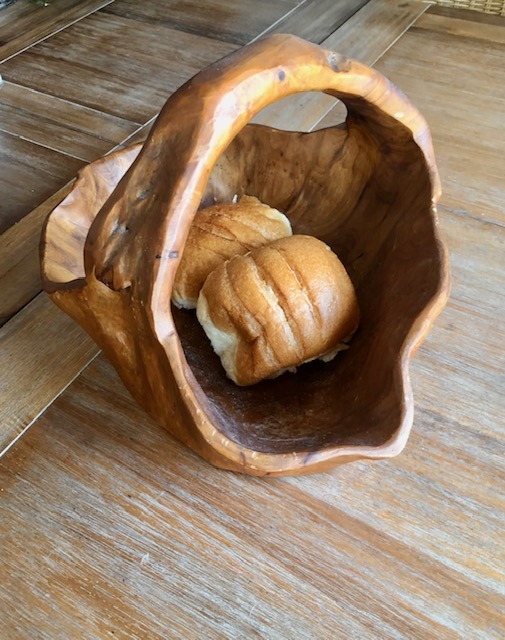
Greetings fellow art lovers. In this week's assignment "Select an artwork from your life", I have chosen this beautiful bread basket. The origin is unknown, or better, I don't remember where I got it, (but probably a garage sale or a thrift shop). It is made out of wood, and specifically of a single block of wood, carved out and polished. I like the fact that the maker of this object used something natural and "alive" like wood to create it. I like that something so "alive" carries my bread. I like its simplicity, and its warmth. I like its irregularity and the wood's imperfections. I see it and use it every single day.
0 notes
Text
Hello , my name is Luigi and little known fact about me is that in the morning, first of all, I must have my espresso.
5 FACTS
1) This is actually a micro painting, measuring only 26.1cm by 18.3 cm
2) The paper used in this painting, called wasli, is an hand made paper made by several sheet of cotton fiber glued together on a wooden board and rubbed until shining with a polished stone. It was invented in India in the 10th century.
3) The artist, Shahzia Sikander, was born in Lahore, Pakistan, and educated in the United States. Because of this multi cultural upbringing, she was able to conflate several cross cultural elements in this painting.
4) She uses traditional islamic painting techniques to express, modern, even rebellious views.
5) This painting expresses a very interesting feminist concept.
This was the first time I encountered this artist and her art. The moment I looked at the image the first impression was to see almost an oneiric, dream like image. I could also recognize elements of Islamic art in it.
After my research, I have to say, my view changed and evolved significantly. I especially liked her idea to re-imagine the figure of a European fairy tale, Little Red Hood, as an Indu goddess with a Muslim veil, bringing together elements of such different cultures.
The fact the the female figure is higher and almost imposing on the male figure in the center is also a refusal, by the artist, of the traditional passive and secondary role given to women in those traditions.
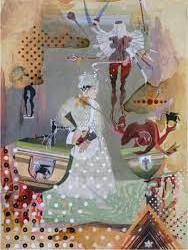
0 notes